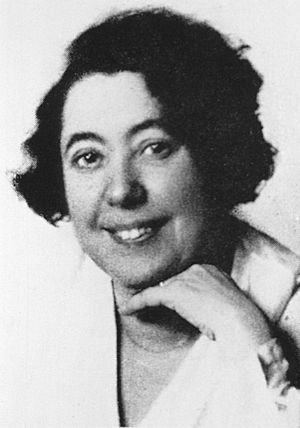Lina Stern facts for kids
Quick facts for kids
Lina Stern
|
|
|---|---|
| Born | 26 August 1878 |
| Died | 7 March 1968 (aged 89) |
| Nationality | Soviet Union |
| Citizenship | Soviet Union |
| Alma mater | University of Geneva |
| Known for | The first female professor at the University of Geneva, the first female member of the USSR Academy of Sciences |
| Awards | Stalin Prize (1943) |
| Scientific career | |
| Fields | blood–brain barrier, biochemistry, neuroscience |
| Institutions | Moscow 2nd Medical Institute, Institute of Physiology, Biophysics Institute |
Lina Solomonovna Stern (or Shtern; Russian: Лина Соломоновна Штерн; August 26, 1878 – March 7, 1968) was a brilliant Soviet biochemist and physiologist. Her medical discoveries helped save thousands of lives during World War II. She is best known for her important work on the blood–brain barrier. She called it the hemato-encephalic barrier in 1921.
Contents
Life and Career Highlights
Lina Stern was born in Libau, which is now Liepāja, Latvia. She grew up in a Jewish family in the Russian Empire. She later studied in Geneva, Switzerland. There, she started a career in science. She did important research in biochemistry and neuroscience.
In 1918, she became the first woman to be a professor at the University of Geneva. She was a Professor of chemio-physiology. She also researched how cells use oxygen, called cellular oxidation. In 1912, Stern worked with other scientists, Frédéric Battelli and Torsten Thunberg. They showed that animal tissue had special enzymes. These enzymes could transfer hydrogen from acids to change the color of methylene blue.
In 1925, she moved to the Soviet Union. She believed in the country's ideas. From 1925 to 1948, she was a professor at the 2nd Medical Institute.
Leading Scientific Research
From 1929 to 1948, Stern was the Director of the Institute of Physiology. This institute was part of the USSR Academy of Sciences. Lina Stern and her team studied many topics, including how long people live and how we sleep.
Under her leadership, different groups of scientists worked together. They studied the hemato-encephalic and histohematic barriers. The results of their work were later used in hospitals. This helped save many lives during World War II. In 1939, she became the first woman to be a full member of the Academy. This is a very high honor for a scientist. In 1943, she won the Stalin Prize for her amazing work.
Understanding the Blood–Brain Barrier
The blood–brain barrier is like a special shield in your brain. It is made by the walls of tiny blood vessels in the brain. This shield stops most substances in your blood from getting into your brain. But it lets small molecules like oxygen and carbon dioxide pass through easily.
Stern's Discoveries
While working at the University of Geneva, Stern published many studies. These studies showed that the blood-brain barrier really exists. She worked with her colleague Raymond Gautier. Starting in 1918, they did careful experiments. They watched how different substances moved from the blood into the nervous system. They figured out how much these substances could enter the brain.
From their studies, they concluded there was a barrier between the blood and the brain. They called it "barrière hématoencéphalique" in French. In 1934, Stern also explained two important ideas. She said the barrier is "selective," meaning it only lets certain things into the brain. She also said it has "resistance," meaning it protects the brain's inner environment from the blood. Today, these are known as two main jobs of the blood–brain barrier.
Activism and Challenges
Lina Stern was a member of the Women's Anti-Fascist Committee. She also joined the Jewish Anti-Fascist Committee (JAC) when World War II began. In January 1949, the JAC faced serious problems. Many members were arrested and sentenced to death. Lina Stern was the only one of 15 people who survived. Her death sentence was changed to a prison term. After that, she was sent away for five years. She lived in Dzhambul, which is now Taraz, Kazakhstan.
Life After Difficult Times
After Stalin died, life became easier for many people. Lina Stern was cleared of her charges. She returned to Moscow. From 1954 to 1968, she led the Department of Physiology at the Biophysics Institute. She often spoke about unfair treatment of Jewish people. She continued her important scientific work until her death.
See also
 In Spanish: Lina Stern para niños
In Spanish: Lina Stern para niños


